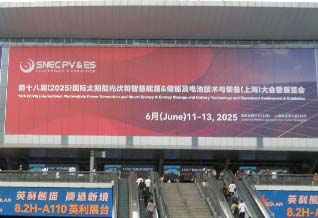Japan Solar Update: No.155 (June 30 ~ July 4, 2025)
SNEC PV+ 2025, one of the world’s largest solar energy exhibitions, was held in June 2025 in Shanghai, China.
Despite the industry currently facing serious challenges—including oversupply and intensifying price competition—companies showed no sign of slowing down in technological innovation. In particular, PV module technology saw remarkable progress.
At the SNEC 2025 exhibition, the once-dominant p-type PERC technology had almost completely vanished, with n-type TOPCon modules taking center stage. Industry leaders including Jinko Solar, JA Solar, Trina Solar, Tongwei, Astronergy, Canadian Solar, DAS Solar, and Risen Energy showcased high-power, high-efficiency modules—many exceeding 750W output and 23% efficiency. Thanks to its balance of mass producibility, cost, and reliability, TOPCon is expected to remain the mainstream technology for the time being.
In contrast, heterojunction (HJT) technology positioned itself as a premium solution focused on achieving even higher efficiencies. State Power Investment Corporation (SPIC) of China introduced an HJT module with copper-plated busbars, aiming to reduce cost and improve performance by replacing silver. SPIC is targeting mass production of 600MW per year starting in 2026. Many other manufacturers also promoted silver-free or silver-reduced module designs.
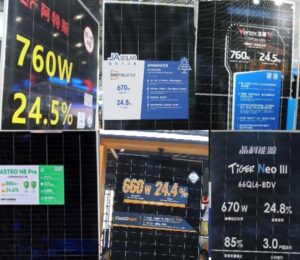
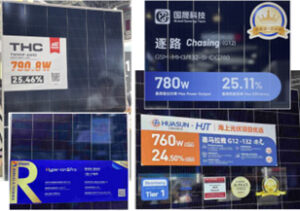
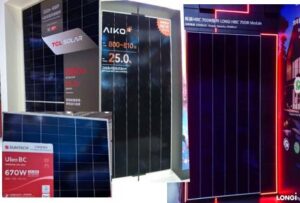 Back-contact (BC) solar cells continued to grow in presence due to their high efficiency and sleek aesthetics. LONGi unveiled a HIBC (Hybrid Interdigitated Back Contact) module that reached an impressive 27.81% conversion efficiency. AIKO Solar projected a 10GW year-on-year increase in BC cell shipments.
Back-contact (BC) solar cells continued to grow in presence due to their high efficiency and sleek aesthetics. LONGi unveiled a HIBC (Hybrid Interdigitated Back Contact) module that reached an impressive 27.81% conversion efficiency. AIKO Solar projected a 10GW year-on-year increase in BC cell shipments.
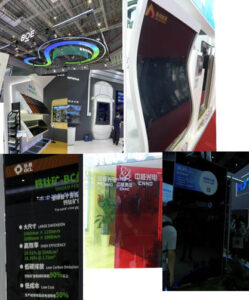 Perovskite technology also gained more attention compared to last year. While scalability has long been a barrier to commercialization, this year’s exhibition showed tangible progress. UtmoLight and Belgium-based imec reported outdoor performance data, and several companies presented 1-meter-wide roll-to-roll films and full-sized modules. In addition to dedicated perovskite manufacturers, many leading silicon-based solar companies introduced perovskite-silicon tandem modules. However, most of these remain in the prototype phase, with full-scale commercialization expected to take several more years.
Perovskite technology also gained more attention compared to last year. While scalability has long been a barrier to commercialization, this year’s exhibition showed tangible progress. UtmoLight and Belgium-based imec reported outdoor performance data, and several companies presented 1-meter-wide roll-to-roll films and full-sized modules. In addition to dedicated perovskite manufacturers, many leading silicon-based solar companies introduced perovskite-silicon tandem modules. However, most of these remain in the prototype phase, with full-scale commercialization expected to take several more years.
Notably, the exhibition wasn’t only about raw output. A wide variety of module designs tailored to specific applications and environments were on display: compact residential modules, colorful and flexible BIPV solutions, and modules optimized for harsh conditions like heat, humidity, snow, marine environments, and deserts. Several modules with built-in microinverters aimed at balcony installations highlighted the growing relevance of decentralized solar solutions.
The integration of solar power and storage was also a clear trend. Many companies showcased residential and commercial energy storage systems that combine batteries and inverters in a single unit—offering easier installation and smarter control capabilities. Large-scale energy storage systems (ESS) for grid applications also remained a hot topic. Numerous rack-based battery systems with capacities exceeding 1MWh were featured. High-density system designs that integrate DC/DC converters, cooling systems, and battery management systems (BMS) are gaining traction, reducing installation footprints and operational costs. Solutions highlighting liquid cooling, modular expandability, and resilience in extreme temperatures were especially prominent.
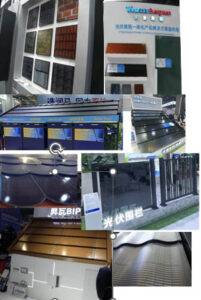

SNEC 2025 clearly reflected the industry’s shift—not just toward higher-performance solar panels, but toward more comprehensive, integrated energy solutions that combine generation, storage, and control. As renewables become a dominant power source, the seamless integration of solar modules, batteries, and energy management is becoming the core of competition. The technology focus is shifting from “maximum output” to “system optimization”—and with that, the boundaries between solar, storage, and smart energy systems are beginning to dissolve.

